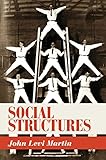Social Structures / John Levi Martin.
Material type: TextPublisher: Princeton, NJ : Princeton University Press, [2009]Copyright date: ©2009Edition: Course BookDescription: 1 online resource (408 p.) : 3 halftones. 47 line illus. 2 tablesContent type:
TextPublisher: Princeton, NJ : Princeton University Press, [2009]Copyright date: ©2009Edition: Course BookDescription: 1 online resource (408 p.) : 3 halftones. 47 line illus. 2 tablesContent type: - 9780691150123
- 9781400830534
- 305
- HM706 .M37 2009
- online - DeGruyter
- Issued also in print.
| Item type | Current library | Call number | URL | Status | Notes | Barcode | |
|---|---|---|---|---|---|---|---|
 eBook
eBook
|
Biblioteca "Angelicum" Pont. Univ. S.Tommaso d'Aquino Nuvola online | online - DeGruyter (Browse shelf(Opens below)) | Online access | Not for loan (Accesso limitato) | Accesso per gli utenti autorizzati / Access for authorized users | (dgr)9781400830534 |
Frontmatter -- Contents -- Acknowledgments -- Preface. From Big Structures to Small -- Chapter 1. Introduction: Social Action and Structures -- Chapter 2. From a Small Circle of Friends to a Long Line of Rivals -- Chapter 3. The Preservation of Equality through Exchange Structures -- Chapter 4. The Institutionalization of Inequality: Pecking Orders -- Chapter 5. The Escape from Comparability and the Genesis of Influence Structures -- Chapter 6. The Short Cut to Structure with Patronage Pyramids -- Chapter 7. The Institution of Transitivity and the Production of Command Structures -- Chapter 8. From Pyramid to Party -- Chapter 9. From Structures to Institutions -- References -- Index
restricted access online access with authorization star
http://purl.org/coar/access_right/c_16ec
Social Structures is a book that examines how structural forms spontaneously arise from social relationships. Offering major insights into the building blocks of social life, it identifies which locally emergent structures have the capacity to grow into larger ones and shows how structural tendencies associated with smaller structures shape and constrain patterns of larger structures. The book then investigates the role such structures have played in the emergence of the modern nation-state. Bringing together the latest findings in sociology, anthropology, political science, and history, John Levi Martin traces how sets of interpersonal relationships become ordered in different ways to form structures. He looks at a range of social structures, from smaller ones like families and street gangs to larger ones such as communes and, ultimately, nation-states. He finds that the relationships best suited to forming larger structures are those that thrive in conditions of inequality; that are incomplete and as sparse as possible, and thereby avoid the problem of completion in which interacting members are required to establish too many relationships; and that abhor transitivity rather than assuming it. Social Structures argues that these "patronage" relationships, which often serve as means of loose coordination in the absence of strong states, are nevertheless the scaffolding of the social structures most distinctive to the modern state, namely the command army and the political party.
Issued also in print.
Mode of access: Internet via World Wide Web.
In English.
Description based on online resource; title from PDF title page (publisher's Web site, viewed 30. Aug 2021)


